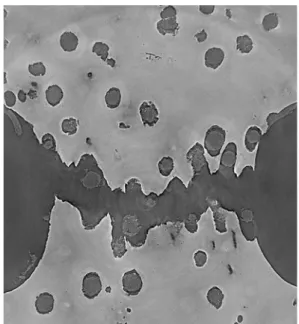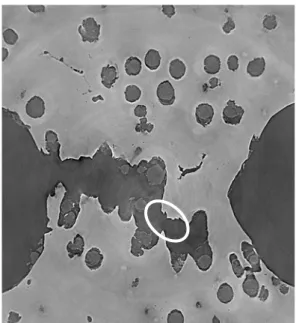HAL Id: hal-01421633
https://hal-mines-paristech.archives-ouvertes.fr/hal-01421633
Submitted on 22 Dec 2016
HAL is a multi-disciplinary open access
archive for the deposit and dissemination of
sci-entific research documents, whether they are
pub-lished or not. The documents may come from
teaching and research institutions in France or
abroad, or from public or private research centers.
L’archive ouverte pluridisciplinaire HAL, est
destinée au dépôt et à la diffusion de documents
scientifiques de niveau recherche, publiés ou non,
émanant des établissements d’enseignement et de
recherche français ou étrangers, des laboratoires
publics ou privés.
Ductile fracture – Influence of heterogeneous
microstructure on nucleation, growth and coalescence
mechanisms
Victor-Manuel Trejo-Navas, Modesar Shakoor, Marc Bernacki, Pierre-Olivier
Bouchard
To cite this version:
Victor-Manuel Trejo-Navas, Modesar Shakoor, Marc Bernacki, Pierre-Olivier Bouchard. Ductile
frac-ture – Influence of heterogeneous microstrucfrac-ture on nucleation, growth and coalescence mechanisms.
NUMIFORM 2016: The 12th International Conference on Numerical Methods in Industrial Forming
Processes, The Minerals, Metals & Materials Society, Jul 2016, Troyes, France. �hal-01421633�
a
Corresponding author: victor-manuel.trejo_navas@mines-paristech.fr
Ductile fracture – Influence of heterogeneous microstructure on
nucleation, growth and coalescence mechanisms
V. Trejo1,a, M. Shakoor1, M. Bernacki1 and P.-O. Bouchard1
1Mines ParisTech, PSL Research University, CEMEF Centre de mise en forme des matériaux, CNRS UMR 7635, CS 10207 rue Claude
Daunesse, 06904 Sophia Antipolis Cedex, France
Abstract. Investigations at the microstructure scale are essential if one wants to predict accurately ductile fracture of
metallic materials under complex multiaxial and non-proportional loadings. An advanced finite element approach based on a level set formalism and body-fitted immersed meshing capabilities enable the modeling of nucleation, growth and coalescence mechanisms for complex 3D microstructures and under large plastic strain. Applications on real microstructures (coming from in-situ laminography) and exact boundary conditions (thanks to Digital Volume Correlation) are studied and discussed for different loading conditions.
1 Introduction
Fracture of materials can be either fragile or ductile. Brittle materials undergo very little deformation before fracture, while ductile materials can sustain considerably higher plastic strains and progressively lose load-bearing capacity before complete failure. The latter are preferred in many applications because of their capacity of absorbing energy before failing.
In the macroscopic study of ductile fracture, a variety of mechanical tests and specimen types are employed in order to assess the effect of the stress state and deformation history on materials’ ductility. This approach is not without limitations: changes in ductility due to thermomechanical processing conditions, non-proportional loading or size effects are difficult to explain without taking into account phenomena at the microscale. Ductile fracture is studied here at the microscale through the mechanisms of nucleation, growth and coalescence of voids. Nucleation events often occur in inclusions either by particle fracture or by debonding in the particle-matrix interface. Plastic flow in the matrix that surrounds voids induces void growth. Finally, coalescence occurs and three possible mechanisms can be observed: internal necking of the intervoid ligament, void-sheet coalescence and necklace coalescence.
A suitable understanding of the micromechanical processes of ductile damage would allow microstructures to be optimized: by controlling microstructural variables such as grain size, and precipitate size and distribution, materials with an optimum compromise between ductility and other mechanical properties can be designed. Additionally, microscale knowledge can feed the development of physics-based macroscopic models that are more transferable and with better prediction
capabilities than phenomenological approaches. The current abstract briefly visits two aspects of the numerical modelling of ductile damage, namely, the role of plasticity in the growth and coalescence of voids, and the study of real microstructures under exact boundary conditions.
2 Methodology
The implemented methodology for the modelling of complex and heterogeneous microstructures is briefly presented in this section. In a collaboration between two other research centers, three techniques are combined in order to obtain an accurate representation of real microstructures: in-situ Synchrotron Radiation Computed Laminography (SRCL) measurements are carried out (Centre des Matériaux, MINES ParisTech) and analyzed via Digital Volume Correlation (DVC) [1] in order to obtain three-dimensional kinematic information (Laboratoire de Mécanique et Technologie - Cachan). The topological information obtained from the SRCL allows the microstructure to be digitally represented with a level-set formalism, and the kinematic information obtained via DVC is used as boundary conditions for a Representative Volume Element (RVE) in numerical simulations of the observations (Centre de mise en forme des matériaux, MINES ParisTech).
The described experimental-numerical approach enables the observation of the ductile damage micromechanisms through information-rich measurements and provides insight into the void nucleation, growth and coalescence phenomena. The subsequent modelling with a robust Finite Element (FE) framework constitutes a powerful virtual testing facility capable of testing the limitations of the physical and
MATEC Web of Conferences
numerical modelling of ductile damage at the microscale. In particular, stress states of engineering interest can be studied thanks to the use of sheet-like experiments in laminography. This approach is summarized in Figure 1.
Figure 1. Scheme of experimental-numerical approach for the
modeling of real microstructures.
3 Results
The aforementioned approach (In-situ laminography-DVC-numerical simulation) was applied to a specimen of nodular cast iron with two laser-drilled holes. In this material; the microvoids are easily appreciable by means of SRCL, which makes it attractive to study the formation of the macroscopic crack between the two holes and the role of the microvoids in this process. Von Mises plasticity and isotropic hardening was employed for the matrix. Cohesive forces in the particle-matrix interface were neglected since they are not particularly significant for this material. The mechanical interaction between the particles and the matrix was also neglected in this first approximation, i.e., the volume of the particles was considered as empty from the beginning of the simulations. A level-set framework, described in the work of Roux et al. [2], was employed in order to represent the void-matrix interface. The level-set reinitialization method proposed by Shakoor et al. [3] was used. A sample of the results is presented in this section for two specimens with the same geometry, but different topological distribution of the heterogeneities.
For the first specimen, Figure 2 shows a section of the specimen obtained via SRCL in the last scan before fracture and Figure 3 shows the macroscopic crack. Figure 2 also displays the strain field obtained from the FE simulation and the void-matrix interface is marked with a white continuous line. Considering that these results are for the last scan before fracture, the shape of the voids was reproduced quite satisfactorily, i.e., void evolution was successfully modeled from its initial state. Strain localization bands are observed between voids in various intervoid ligaments; some of these bands are almost horizontal (an indication of possible coalescence by internal necking), while others are inclined and between voids seemingly wide apart (a sign of possible void-sheet coalescence). Indeed, when comparing Figures 2 and 3, coalescence of voids is observed in many of the
regions where the FE simulation predicted strain localization.
Figure 2. Section of the microstructure before fracture for
specimen 1 and strain field obtained from FE simulation.
Figure 3. Section of the microstructure after fracture for
specimen 1.
Similar results are observed for the second specimen in Figures 4 and 5: a very satisfactory prediction of the void shape is observed in the pre-crack stage and strain localization is present in the region where the macro-crack is formed. However, in the region marked with a white circumference in the figures, the FE model predicts diffuse plastic strain, while the post-fracture shows void coalescence in that same zone presumably by void-sheet mechanisms. One possible reason for the absence of strain localization in the numerical results is the fact that the mechanical contribution of the graphite inclusions was not taken into account. Another possible reason might be represented by plasticity-related assumptions such as isotropic plasticity during void growth and also during coalescence.
The strain field in the border of the numerical domain exhibits a rather heterogeneous behavior. This is due to the use of real boundary conditions obtained from DVC. Since the distribution of the inclusions is far from being
NUMIFORM 2016
homogeneous, the use of real boundary conditions is crucial to include the effect of the microstructure outside of the computational domain and to obtain a realistic description of the micromechanics inside the domain. The observed level of non-homogeneity in the boundaries of the domain as well as in the close vicinity of some voids is interesting considering how often the assumption of periodic arrays of voids is used in the development of behavior laws for porous media.
Figure 4. Section of the microstructure before fracture for
specimen 1 and strain field obtained from FE simulation.
Figure 5. Section of the microstructure after fracture for
specimen 2.
4 Conclusion and discussion
The experimental-numerical methodology for the modelling of heterogeneous microstructures via in-situ laminography, DVC and FE simulations constitutes a powerful tool for the understanding of the mechanisms of ductile damage at the microscale. It also permits to assess the limitations of different physical models (behavior laws and void nucleation and coalescence criteria, for example) in situations of engineering interest (thanks to the use of sheet-like specimens in SRCL) with real
microstructures and exact boundary conditions. The results obtained with this approach have the potential to improve the current understanding of ductile damage and to boost the development of more realistic and physically based macroscopic behavior laws. Isotropic von Mises plasticity may not be adapted for the matrix at this scale and a more advanced description of plasticity may be needed to improve FE simulations results. Microvoids in nodular cast iron are easily appreciable in laminography observations; applying the herein presented approach to other materials is a perspective.
Acknowledgements
The authors would like to gratefully thank the French ANR for funding the COMINSIDE project.
References
1. T. F. Morgeneyer, L. Helfen, H. Mubarak and F. Hild, Experimental Mechanics, vol. 53, n° 14, pp. 453-556, 2013.
2. E. Roux, M. Bernacki, P.-O. Bouchard, Computational Materials Science, vol.68, pp. 32-46, 2013.
3. M. Shakoor, B. Scholtes, P.-O. Bouchard and M. Bernacki, Applied Mathematical Modelling, vol. 39, n° 123, pp. 7291-7302, 2015.

